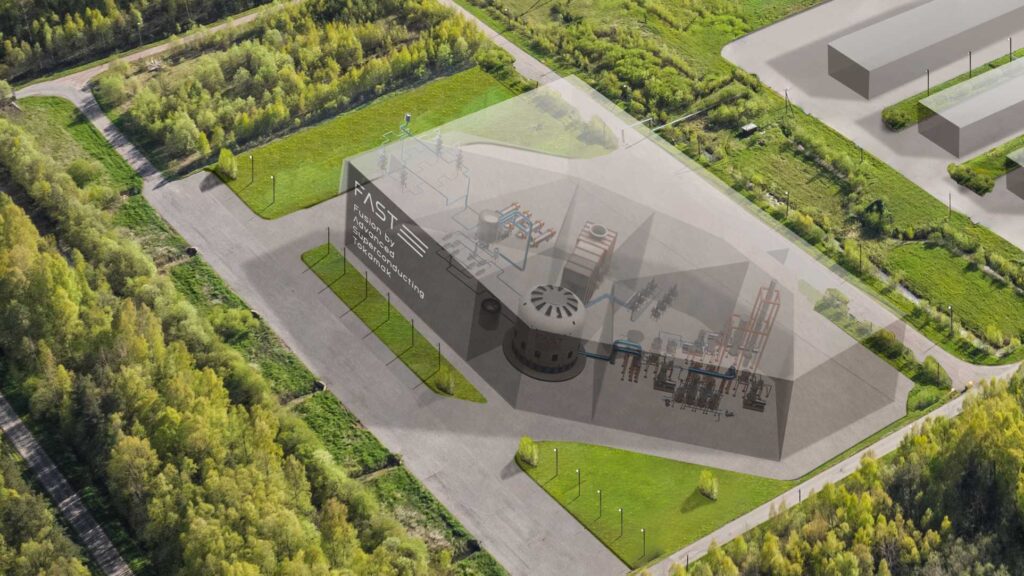Completion of Conceptual Design for the Fusion Energy Demonstration Project “FAST” and Publication of Japan’s First Private-Sector-Led Conceptual Design Report (CDR)
Achieving a Major Milestone Toward Power Generation Demonstration in the 2030s and Moving Forward to Engineering Design
Starlight Engine Ltd. (SLE), which leads the industry-academia collaborative project “FAST (Fusion by Advanced Superconducting Tokamak)” aimed at demonstrating power generation in Japan in the 2030s, together with Kyoto Fusioneering Ltd. (KF), an engineering company specializing in fusion energy plants, have announced the completion of the conceptual design for the FAST device—the project’s first major milestone—and the release of the “Conceptual Design Report (CDR)” summarizing the design information.
Following collaboration involving both companies and leading researchers from major Japanese universities and public institutions, the conceptual design was completed in one year since the launch of the project in November 2024. This marks the first CDR compiled in response to the Cabinet Office’s “Fusion Energy Innovation Strategy” for a privately led fusion power demonstration project in Japan. At the same time, FAST has disclosed its basic safety design principles through dialogue with the Nuclear Regulation Authority and outlined fundamental site requirements to advance preparations for site selection, paving the way for the next phase: engineering design.

1. FAST Project Overview
The “FAST” Fusion Energy Power Generation Demonstration Project is a private-sector-led initiative that paves the way for the commercialization of fusion energy. The project is spearheaded by SLE, with participation from leading Japanese researchers in tokamak devices and plasma physics, including Professor Akira Ejiri (The University of Tokyo), Professor Takaaki Fujita (Nagoya University), and Assistant Professor Kenzo Ibano (Osaka University). In addition, Kyoto Fusioneering, Sumitomo Mitsui Banking Corporation, Electric Power Development (J-Power), JGC JAPAN Corporation, Hitachi, Fujikura, Furukawa Electric, Marubeni Corporation, Kajima Corporation, Kyocera, Mitsui & Co., Mitsui Fudosan, and Mitsubishi Corporation are among the companies supporting and collaborating in this industry-academia partnership.
The FAST Project adopts a low-aspect-ratio tokamak design to generate and sustain burning plasma capable of inducing fusion reactions (D-T*). It aims to demonstrate an integrated fusion energy power generation system that combines energy conversion, fuel breeding and fuel cycle systems, and maintenance operations. Through this demonstration, the project seeks to address technical challenges toward commercialization. Furthermore, by verifying the technologies required for power generation in an integrated manner, FAST will establish a robust supply chain leveraging Japan’s advanced manufacturing capabilities.
Note: *Refers to a fusion reaction using deuterium and tritium.
2. Completion of Conceptual Design and Future Schedule
Since the launch of the FAST project in November 2024, we have been working toward achieving a critical milestone known as “Conceptual Design.” This process involves designing the fusion energy plant for power generation demonstration, assessing technical and engineering feasibility, clarifying the project direction, conducting safety and economic evaluations, and defining the plant’s fundamental design specifications.
With the completion of the conceptual design phase, the project will now shift to engineering design, accelerated engineering R&D, and will proceed with site selection, site preparation, regulatory approvals, and the procurement of long-lead items, with the aim of construction after 2028. The recently completed conceptual design represents a pivotal milestone that underpins all subsequent processes. The resulting CDR serves as the foundation for the plant’s design.
The FAST CDR consolidates the plant’s objectives, required performance, system configuration, feasibility, and the cost and schedule necessary for construction. During the conceptual design activities, SLE and KF defined demonstration themes such as power generation technology, tritium cycle, and remote maintenance, determined the required fusion output, and finalized the major specifications for components including superconducting coils and blankets. Experts in plasma physics, plant engineering, and plant design collaborated to ensure scientific and engineering feasibility throughout the process. This CDR marks the starting point for engineering design and facilitates investment decisions by government and industry, as well as regulatory discussions.
Leveraging the expertise of researchers and engineers with decades of experience in JT-60SA, ITER construction, and DEMO plant design studies, combined with Kyoto Fusioneering’s proven plant technologies, FAST completed this process in just one year―a task that typically takes several years. By integrating experience from public institutions and ITER’s design database, SLE and KF successfully produced the first CDR for a power generation demonstration project responding and aligned with Japan’s national “Fusion Energy Innovation Strategy.”
As a private-sector-led initiative, FAST benefits from rapid decision-making compared to government-led projects that require policy consensus, enabling advancements toward the industrialization of fusion energy at pace. FAST will transition from the conceptual design phase to the engineering design phase, with plans underway to complete the Engineering Design Report (EDR) by 2028.
In parallel, SLE and KF are publishing site requirements and engaging with multiple regions and organizations to advance site selection. SLE and KF have also released the “Basic Policy for Safety Assurance” to facilitate dialogue with The Nuclear Regulation Authority of Japan ensuring steady progress toward construction. Additionally, plans are underway to secure funding in 2026 to support engineering design and R&D activities.
3. Key Features of FAST
・Design for Early Achievement of Scientifically and Technically Meaningful Fusion Output and Power Generation:
Building on the solid foundation of decades of tokamak research, FAST maximizes fusion reactions through NBI (Neutral Beam Injection) heating, achieving approximately 50 MW of fusion output with a JT-60SA-class device. By combining the proven technologies of JT-60SA with Japan’s world-class manufacturing capabilities, FAST presents a design that enables Japan to construct a fusion plant in the shortest and most reliable way.
Meanwhile, in the previously unexplored global domains of energy conversion and fuel cycle, KF is leading the way with its proprietary facilities “UNITY-1, UNITY-2,” advancing technology demonstrations. These efforts provide the technical foundation necessary to achieve, for the first time globally, both the generation and extraction of fusion energy. FAST embodies a uniquely Japanese approach that balances high feasibility with bold innovation.
・Integrated Demonstration of Commercial Plant Technologies at Relevant Scale:
FAST will be the first in the world to integrate and demonstrate essential technologies for commercial fusion plants—such as high-temperature superconducting coils and blankets for fuel breeding and heat extraction—at relevant scale. Furthermore, power generation demonstration via heat exchangers, along with remote maintenance and component replacement technologies, will be accelerated, as these are indispensable for practical energy deployment. Beyond the power generation demonstration in the 2030s, FAST will continue to serve as a platform for “next challenges,” including testing advanced blankets, innovative divertors, and new materials.
4. Comments from Project Leaders
Kiyoshi Seko, CEO of Starlight Engine Ltd. / President and COO Kyoto Fusioneering Ltd.
I am delighted that we have successfully achieved one of the key milestones toward power generation demonstration in the 2030s. At the same time, I feel deeply reassured by the expertise, experience, and passion of all the members involved. Completing the conceptual design in just one year is a result of Japan’s decades of research achievements. I would like to express my sincere gratitude once again to the National Institutes for Quantum Science and Technology (QST), the National Institute for Fusion Science (NIFS), and all those in academia and industry who have contributed to fusion research.
FAST is now moving into the engineering design phase. We will harness the strength of Japan’s manufacturing industry and accelerate the project with a sense of urgency, mobilizing Japan’s full capabilities to realize fusion energy as soon as possible.
Satoshi Konishi, Co-Founder and CEO of Kyoto Fusioneering Ltd.
First and foremost, it’s a great achievement to complete the conceptual design activities within the planned one-year timeframe. We succeeded in creating an innovative design that incorporates new technologies essential for commercial plants, such as high-temperature superconducting (HTS) magnets, liquid breeding blanket systems, and highly efficient tritium fuel cycle systems, by mobilizing domestic experts. Preparations for safety design, regulatory approvals, and site selection are steadily progressing.
In the next engineering design phase, we expect to fully leverage our strengths in plant engineering and our broad network across diverse industries, including finance and construction. While balancing business operations, we will continue to work together as one team to advance this project.
Kenzo Ibano, Assistant Professor, Osaka University
Thanks to the power of industry-academia collaboration, we have successfully produced Japan’s first CDR for a power generation demonstration project. I am proud of our team and feel a renewed sense of responsibility as we prepare to embark on the detailed engineering design process.
Working alongside researchers with decades of experience and private-sector partners in driving this project forward is both stimulating and rewarding, giving a strong sense of mission. I will continue to dedicate myself to ensuring steady progress of the FAST project toward the realization of fusion energy.
The CDR announced today will also be presented at the 42nd Annual Meeting of the Japan Society of Plasma Science and Nuclear Fusion Research, held from Monday, December 1 to Thursday, December 4, 2025.
https://www.jspf.or.jp/jspf_annual2025
You can download the following PDF files:
- Basic Policy for Safety Assurance (in Japanese)
- Site Requirements (in Japanese)
FAST Website: https://www.fast-pj.com/en
Starlight Engine Website: https://sle.energy
Kyoto Fusioneering Website: https://kyotofusioneering.com/en




